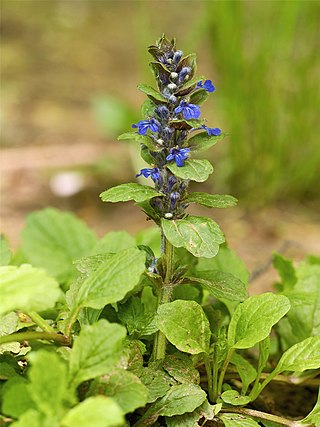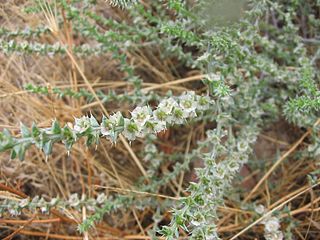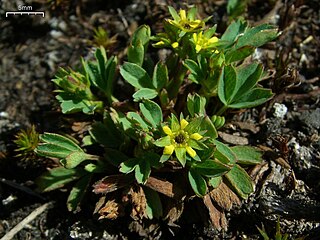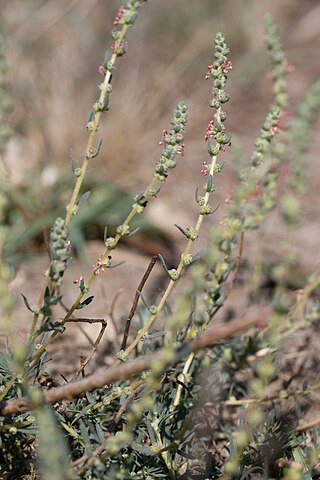
Ajuga, also known as bugleweed, ground pine, carpet bugle, or just bugle, is a genus of flowering plants in the Ajugeae tribe of the mint family Lamiaceae. There are over 60 species of annual or perennial, mostly herbaceous plants. They are native to Europe, Asia, Africa, and Australia.

The Salsoloideae are a subfamily of the Amaranthaceae, formerly in family Chenopodiaceae.

Corispermum is a genus of plants in the family Amaranthaceae. Common names given to members of the genus involve bugseed, tickseed, and tumbleweed. In general, these are erect annual plants with flat, thin leaves and topped with inflorescences of flowers with long bracts. Bugseeds are native to North America and Eurasia, but little is known about their taxonomy and distribution.

Eduard August von Regel, Russian: Эдуард Август Фон Регель; was a German horticulturalist and botanist. He ended his career serving as the Director of the Russian Imperial Botanical Garden of St. Petersburg. As a result of naturalists and explorers sending back biological collections, Regel was able to describe and name many previously unknown species from frontiers around the world.

Kali is a genus of plants in the subfamily Salsoloideae in the family Amaranthaceae. Common names of various members of this genus include buckbush, rolypoly, tumbleweed for its wind-blown seed dispersal habit, and Tartar thistle and Russian thistle for its origins.

Anabasis is a genus of plants in the subfamily Salsoloideae of the family Amaranthaceae. It is distributed in southern Europe, North Africa, and Asia.

Ziziphora are a genus of annual or perennial herbs or subshrubs in the family Lamiaceae. Ziziphora has aromatic leaves; they are found in open and often xeric habitats in Southern and Eastern Europe, North-West Africa and Asia to the Himalayas and Altai mountains.

Seidlitzia a genus of flowering plants belonging to the family Amaranthaceae. It is also in the Salsoloideae subfamily.

Sibbaldia is a genus of flowering plants of the family Rosaceae, with a circumpolar distribution, including the high Arctic. Most of the species are found in the Himalaya. The type species is Sibbaldia procumbens. It is also in the Rosoideae subfamily.

Ceratocarpus is a genus of flowering plants in the family Amaranthaceae. It has only one currently accepted species, Ceratocarpus arenarius, found in Bulgaria, Romania, Crimea, Russia, Anatolia, the Caucasus, Iran, Afghanistan, Pakistan, Central Asia, the Altai, western Siberia, Xinjiang in China, and Mongolia. A bushy herbaceous plant, no more than 30 cm tall, it is a valuable fodder for sheep, goats and horses, and it grows well in degraded and trampled soils.

Camphorosma is a genus of flowering plants in the family Amaranthaceae, found in northern Africa, southern and eastern Europe, Crimea, Russia, Anatolia, the Caucasus, Iran, Afghanistan, Pakistan, Central Asia, the Altai, western Siberia, Xinjiang in China, and Mongolia. Annuals or subshrubs, they can be distinguished from closely related taxa such as Bassia by their flattened perianths which have four lobes, inflorescences with multicellular glandular hairs, a distinct C4 leaf anatomy type (called the Camphorosma type), and a chromosome count of 2n = 12.
Rindera is a genus of flowering plants belonging to the family Boraginaceae.
Iljinia is a monotypic genus of flowering plants belonging to the family Amaranthaceae. It only contains one species, Iljinia regelii(Bunge) Korovin ex Iljin

Grubovia is a genus of flowering plants belonging to the family Amaranthaceae.
Sibbaldianthe is a genus of flowering plants belonging to the family Rosaceae. It is also in the Rosoideae subfamily.
Schulzia is a genus of flowering plants belonging to the family Apiaceae.

Rochelia is a genus of flowering plants belonging to the family Boraginaceae. It is also in subtribe Eritrichiinae.
Gamanthus is a genus of flowering plants belonging to the family Amaranthaceae.

Halimocnemis is a genus of flowering plants belonging to the family Amaranthaceae.

Hammada is a genus of flowering plants belonging to the family Amaranthaceae. It is also in the Salsoloideae subfamily. Although it is a very unclear and unsorted genus with many species that have later been classed as synonyms.















